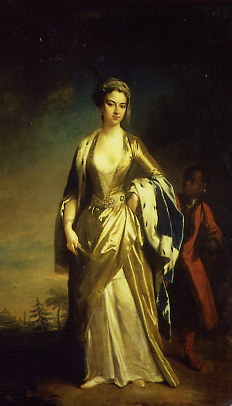& about TREASURE HUNT National Trust Acquisitions
This relatively new born blog-written by Emile de Bruijn is indeed the rarest of treasure. About the HUNT Emile says: "National Trust curators are always on the look-out for works of art and other chattels that have ‘escaped’ from the historic houses in their care. I help to co-ordinate these ‘treasure hunts’, and in this blog I present our acquisitions in their historic context."
recently this came up-
Little Augury to Emile de Bruijn of Treasure Hunt:
(read Our Conversation here too- )
Love this portrait and period,( referring to a portrait in the Treasure Hunt post). Lady Mary Wortley Montagu is on the top of my list of iconic women. There are several portraits of Lady Mary that depict this same Turkish style
(little augury referring to this)
Lady Mary Wortley Montagu by Johnathan Richardson
"We travelers are in very hard circumstances.
If we say nothing but what has been said before us,
we are dull and have observed nothing.
If we tell anything new,
we are laughed at as fabulous and romantic."
lady mary wortley montagu
Emile of Treasure Hunt in reply:
The artist Jean-Etienne Liotard also played a role in popularising Turkish dress. His ravishing pastel portrait of Laura Tarsi (early 1740s) has recently been acquired by the Fitzwilliam Museum, Cambridge: http://www.fitzmuseum.cam.ac.uk/gallery/recentacquisitionsdrawingsprints/gallery/16.html-
following Emile's link takes you to this-
Jean-Etienne Liotard's portrait of Laura Tarsi
to which little augury replies:
Look at this image of MWM as compared to the Liotard http://www.jamessmithnoelcollection.org/images/lady%20mary%20wortley%20montagu.jpg
the link takes you here-
the engraving states-
from an original miniature in possession (1844) of the Earl of Harrington
To which Emile replies:
Yes this portrait was thought to depict Lady MWM in the past. However, according to the Fitzwilliam’s acquisition records, it has now been established that the sitter was a Greek girl living in Constantinople called Laura Tarsi. She was probably the mistress of John Manners, Marquess of Granby, who commissioned this portrait from Liotard when in Constantinople on the Grand Tour.
Lady MWM did know Granby, and of course she was famous for wearing Turkish dress, so that may have caused this portrait to become associated with her – an interesting example of celebrity myth-making.
Laura Tarsi-A star is Born!
image from The Fitzwilliam Museum here
watercolour on ivory
from the Estate of the 10th Duke of Rutland
This extraordinary Liotard painting never ceases to grab my attention. The painting evokes all of the intrigue of a period in the 18th century for exotic Turkish dress in portraiture. Liotard is the painter that exemplifies this best. Here- Liotard's sitter wears a deep green robe embellished with brocade bands of gold. The robe is lined in a printed fabric seen in the painting just inside the sleeves. The cerulean velvet gown is again trimmed in gold bands- lined in what appears to be a stripe. Liotard's expertise with the brush tells the story with great clarity. The gold necklaces, drop earrings and large belt buckle were certainly authentic pieces from Constantinople- Laura Tarsi wears an extravagant turban encrusted with jewels completes the costume.
below-another of the Liotard portraits of Laura Tarsi
Presumed portrait of Laura Tarsi in Turkish dress
($638,500 in 2009 from Christie's-here)
from Christie's:
This previously unrecorded image and three other versions of it have traditionally been considered portraits of Laura Tarsi, a Greek woman thought to be the mistress of the Marques of Granby (1721-1770) when both were living in Constantinople in the 1740s... Although the identification of the sitter cannot be confirmed definitively, this type of portrait of a Western woman in exotic dress is one at which Liotard excelled and made popular while in Constantinople and after his return to Western Europe... The sitters in a number of Liotard's portraits are wearing variations of the same costume... One can imagine Liotard keeping these costumes in his studio for models and other sitters to wear, and the commissions could have been for specific portraits in turquerie style or of beautiful and exotic images in an Orientalist style.
I told you it would be a treasure hunt-
Go to Treasure Hunt and get caught up in Emile's de Bruijn exploration of recovering Britain's National Treasures.
more about Liotard from Christie's
Born to French parents in Geneva, Liotard was an extremely well-travelled artist whose portraits were highly sought-after throughout Europe and beyond. He trained as an enamel painter and miniaturist before continuing his training in Paris, under Jean-Baptiste Massé, miniature painter to Louis XV. In 1735 he travelled to Italy in the retinue of the French Ambassador, and three years later moved to Constantinople, where he established himself in the European community. During his four-year stay there, Liotard famously adopted Ottoman-style costume (for which, as a European, he would have required special dispensation) and grew a long beard. He retained both after leaving Turkey in 1742, and not surprisingly gained renown as the 'Turkish painter' in the many European capitals (including London) where he worked over the following decades. Many of his sitters, male and female, chose to be depicted in similarly exotic costume. Laura Tarsi's outfit epitomises the layered look and richly embroidered fabrics that enjoyed such a vogue among fashionable Europeans.
.







